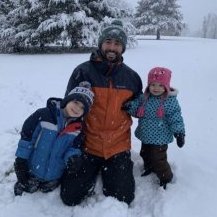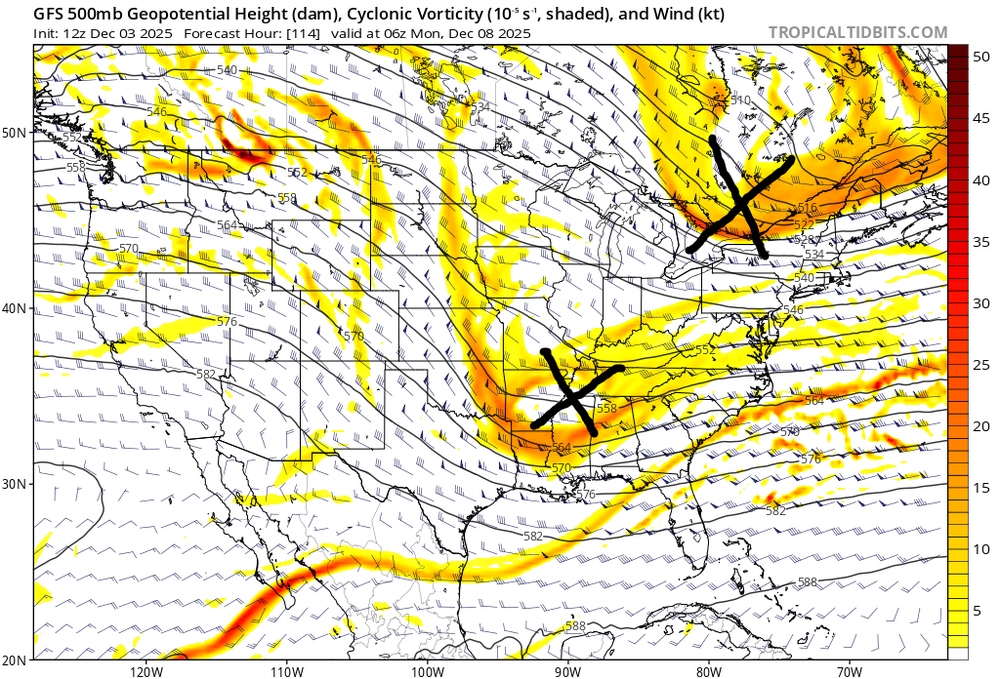-
Posts
26,607 -
Joined
-
Last visited
Content Type
Profiles
Blogs
Forums
American Weather
Media Demo
Store
Gallery
Everything posted by psuhoffman
-
With a weaker STJ and a stronger NS (both typical in a Nina base state) it's not unusual for a lot of these waves to end up too weak or suppressed. There is a reason the snowfall minimum (wrt averages) is pretty much right over us in a Nina. There is a better chance of more snow wrt average if you go in any direction...we are too far south for the NS dominant systems and too far north for the weaker STJ systems in a nina pattern. This is a generalization and not to be applied to every situation...but it's going to end up truth in the means over the longer periods...what we have seen is not some bad luck, its what happens in this type of pattern. We need to get out of it.
-
We’ve been in a Nina ish pacific base state for a long time. That isn’t good for gulf miller a type systems.
-
write a letter, make sure they know
-
If you take a step back and just look at the larger pattern progression it might be the period that makes the most sense...but it's also the furthest out of all the concrete threats.
-
What I will say is that I decided to let my "slightly above average snowfall" seasonal forecast ride. And nothing I've seen so far makes me regret that.
-
This is what I meant in my last comment about so many permutations...the CMC actually made the changes we need with the NS, but it has a weaker more disjointed southern system and has this little kicker behind it that wasn't there before or on other guidance...so it ends up with the same result. If you had that NS look from the CMC with the GFS/Euro TN valley look...it would be a snowstorm for us. But I'm not good enough to figure out all these little variables from this range and I am not going to project false confidence and pretend I am.
-
There are so many variables and permutations...they all matter to some degree. I was not even really focusing on that feature, which does NOT mean it's not important, just means it wasn't where my attention was...the Mexican energy mostly washes out and the wave that ends up in the TN valley is from the energy that comes into the PAC NW and ejects from the Rockies around 100 hours. IMO the wave is healthy enough, the biggest problem is the timing and strength of that NS wave in front of it and the orientation of the NS. If we can just get one change...that is the one I would look for. But there are a ton of variables...we could root for a ton of other little factors that could lead to a better result...better phasing between that Mexican energy and the PAC wave leading to an even stronger TN valley system...changes in the timing of that system, if it were to slow down by 12-24 hours...but then does that introduce temp issues...UGH see it gets complicated and I am trying to keep it simple lol
-
It's far enough out that making that kind of determination is risky. I will say this...if the northern stream is very close to what is being depicted right now...its a threat for the southern mid atlantic. If the northern stream were to relax some or that wave were to get ahead more and out of the way...it becomes a threat for our area perhaps...but would still have a cap to how far north it could make it...and my biggest fear would still be a fringe, if the northern stream wave were to be further behind...and possibly phase...that would open the door to a coastal climbing system that could threaten further north. I have no read on this, I've not had time to really dig in more than some superficial analysis... so I am not going to pretend to have any insight into which way it's more likely to go.
-
I don't think it's a mirage...the setup has the potential for an actual snowstorm. We need the timing of a northern stream wave to change. If it does...and asking for that kind of change at this range is not crazy...the setup is there. That doesn't mean, of course, we will get the changes we need...but I don't think the threat is dead yet. 12z GFS The problem is there is a wave coming across right on top of the potential system as it's entering the TN Valley...suppressing it right at the critical moment for our purposes. If that wave to our north is 12 hours further along...there might be room...if it is 12 hours further behind...it opens the door to a phase in a helpful way instead of a suppressive impact. There are options here that very reasonable changes to this depiction could very easy result in snow for our area. Most of the ingredients we need for a snowstorm are right there...with just one thing we need to get out of the way. I wouldn't give up on it yet.
-
I don't usually let busts get to me anymore...but that one...yea that one...
-
Two things can be true. The euro products are still the best, and if you can only have one thing in your corner that is the one you want...but the euro is not so dominant over all other guidance that it's typically right when it's all on its own. If that was true forecasts would just be a rip and read copy of the euro. A consensus between all the guidance is still typically more accurate than any one model. The real skill is knowing when one model "Might" be on to something that others are missing. Using experience and history and pattern analysis to try to figure out what the right weights are in each specific situation.
-
When’s it gonna start. Patiently waiting
-
Methuselah?
-
That’s good. Precip is in and out in 6 hours. Our best shot is a heavy thump that dynamically cools the column enough to overcome the WAA for a few hours. There is no scenario where we get a slow moving prolonged frozen event.
-
Dew point is 18. This doesn’t feel like the typical warm bust when we were 50 the day before and sitting here with a dealing already in the upper 20s.
-
I went to Oakton. ‘97.
-
It's a very marginal setup...the HRRR and GFS aren't in actuality THAT far from the other guidance...they are just 1-2 degrees colder and have the precip come in a little harder initially...that combo is the difference between a thump snow along our NW fringe regions...and not. It's not like the guidance is showing some vastly different outcome...its just the minor differences have rather significant impacts on the ground truth in this case.
-
There is a reason I let my slightly above average snowfall forecast ride even while many were jumping ship over the last 2 weeks. My gut says something is different. We will see, maybe I just ate something...
-
Storm cancel December Cancel Winter Cancel
-
This is perception bias. It does happen in reverse. The vast majority of our actual snowstorms were not on the guidance 174 hours out. And very often not showing that much snow...even at 72 hours. They trended into something in the last 48-72 hours... just like most of our "fantasy digital threats" trend away form something...because the truth is the odds of the guidance being exactly right from range is low. Very rarely do we get a snowstorm where the guidance nailed it from really far out. The first Feb 2010 storm...January 2016 were rare exceptions not the norm. And the reason it feels like we get way too many "false threats" is also perception bias. We register every potential threat as if "the models say it's going to snow" WHich models? Did they all? And when...did they have a threat at day 8 then lost it by day 6...which day is the one that matters...if we count every day through the whole winter where a couple models spit out a permutation with snow...as a legit threat and expect that snow to happen...that is on us...that is a failure of our perception not guidance. All that said our guidance is not perfect...its flawed...and we need to continue to work to improve our ability to forecast both with models and through other means. But you're compounding this by falling victim to typical perception biases.
- 750 replies
-
- 11
-

-

-

-
I think the only hope for a snowier outcome (and even then it’s mostly for the NW fringes of the forum, is for it to come in hot and heavy and the dynamic cooling and mixing of the column keeps it isothermal near 32 long enough to get the classic thump surprise. We’ve seen it happen. But it’s not something we can nail down ahead of time usually.
- 750 replies
-
- 13
-

-

-
What part of Hanover are you?
-
There is a breakfast place in Manchester called Dutch Corner. Christmas Tree Park a few blocks up the road might be a nice place for a Jebwalk also. If you end up in this area.
-
Yes it’s better if it snows before mid December in our northern and colder regions but it’s even better if the storm hits everyone. I know it was in jest.
-
When I isolated all our December snowfalls and looked at what factors seemed to be most common by far the PNA and EPO had to be favorable. With the caveat that the AO is still the most common indicator. But that is universal across every possible pattern and time of year. If the AO is positive it's just hard for the jet stream to be suppressed enough to get a system to stay under us. But in terms of the pacific (EPO/PNA) v atlantic (NAO) the pacific was definitely more important. Not necessarily both but it was almost unheard of to get a snowfall early in the season if both the EPO and PNA were unfavorable. Having the NAO also certainly helps...but the NAO alone without any help from the PNA/EPO doesn't do us much good in December.





